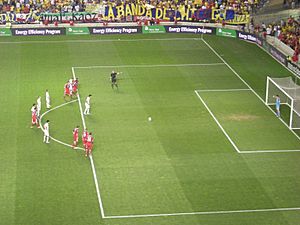Penalty shot facts for kids
A penalty shot or penalty kick is a special chance to score a goal in many sports. It happens when a player on one team breaks a rule in a serious way. Because of this foul, the other team gets a free shot at the goal.
The rules for taking a penalty shot are different in each sport. Sometimes, penalty shots are used in a bigger "penalty shootout." This shootout helps decide the winner when a game ends in a tie.
Contents
Association Football
In association football, also known as soccer, a penalty kick is given when a serious foul happens inside the penalty area. This area is close to the goal. The kick is taken from a special spot called the penalty mark. This spot is 12 yards (about 11 meters) from the goal line.
Only the opposing team's goalkeeper can defend the goal. All other players must stay outside the penalty area until the ball is kicked. The goalkeeper must also stay on their goal line until the ball is touched. If the game is still tied after extra time, a penalty shootout decides the winner. In a shootout, players take turns kicking from the penalty spot, but they cannot score from a rebound.
Bandy
In bandy, a penalty shot is given when a foul happens inside the opponent's penalty area. This foul would normally result in a free-shot. The rules for when and how to take a penalty shot are found in the official Bandy Playing Rules.
If a bandy match is tied at the end, a penalty shot competition can be used. This helps decide which team wins. It can happen after extra time or instead of it.
Gaelic Football
In Gaelic football, a penalty kick can be given if a defender commits a foul. This foul must happen inside the large rectangle area around the goal. The player takes the penalty kick from the ground. It is taken from the center of the 11-meter line. Only the goalkeeper is allowed to guard the goal during this shot.
Ice Hockey
In ice hockey, a penalty shot is awarded to a player. This happens if an opponent fouls them and stops a clear scoring chance. When a penalty shot is given, all other players must leave the ice. The fouled player then faces only the opposing team's goaltender.
The puck is placed at the center of the ice rink. The player has twenty seconds to skate with the puck and try to score. The penalty shot ends if the puck crosses the goal line or is blocked. It also ends if the puck stops moving or goes backward. If the player loses control of the puck, the shot is also over.
Polo
In polo, a penalty shot can be awarded for certain serious fouls. For example, if a player commits a very rough foul, they might get a red card. This means their team plays with one less player for four minutes. On top of that, the other team gets a penalty shot if the foul happened during the game.
Rugby
In rugby, if a team breaks a rule, the other team can choose to take a penalty kick at goal. This kick is taken from where the foul happened. In rugby league, a successful penalty kick is worth two points. In rugby union, it is worth three points.
Water Polo
In water polo, a penalty shot (or "throw") is given when a defender commits a major foul. This foul must happen within the six-meter area. It must also prevent a likely goal from being scored.
Similar Plays
Some other sports have plays that are like penalty shots:
- In field hockey, a penalty stroke or a penalty corner is given after a foul.
- Free throws in basketball are similar to penalty shots. They are much more common because scoring happens more often in basketball.
- Gridiron football does not have a direct penalty shot. Instead, if an illegal act stops a score, officials can use an "unfair act" rule. This allows them to give any penalty they think is fair, including awarding the score automatically.
See also
 In Spanish: Penalti para niños
In Spanish: Penalti para niños



